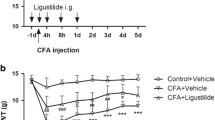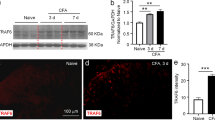Abstract
The present study was designed to characterize the possible roles of spinally located cholera toxin (CTX)- and pertussis toxin (PTX)-sensitive G-proteins in pro-inflammatory cytokine induced pain behaviors. Intrathecal injection of tumor necrosis factor-a (TNF-a; 100 pg), inter-leukin-1β (IL-1β; 100 pg) and interferon-γ (INF-γ; 100 pg) showed pain behavior. Intrathecal pretreatment with CTX (0.05, 0.1 and 0.5 mg) attenuated pain behavior induced by TNF-α and INF-γ administered intrathecally. But intrathecal pretreatment with CTX (0.05, 0.1 and 0.5 μg) did not attenuate pain behavior induced by IL-1β. On the other hand, intrathecal pretreatment with PTX further increased the pain behavior induced by TNF-a and IL-1 β administered intrathecally, especially at the dose of 0.5 μg. But intrathecal pretreatment with PTX did not affect pain behavior induced by INF-γ.Our results suggest that, at the spinal cord level, CTX- and PTX-sensitive G-proteins appear to play important roles in modulating pain behavior induced by pro-inflammatory cytokines administered spinally. Furthermore, TNF-α, IL-1 β and INF-γ administered spinally appear to produce pain behavior by different mechanisms.
Similar content being viewed by others
References
Choi, S. S., Han, K. J., Lee, J. H., Lee, H. K., Han, E. J., Kim, D. H., and Suh, H. W., Antinociceptive mechanisms of orally administered decursinol in the mouse.Life Sci., 73, 471–485 (2003).
Chung, K. M., Differential modulatory roles of cholera toxin and pertussis toxin in the regulation of pain responses induced by excitatory amino acids administered intrathecally in mice.Brain Res., 867, 246–249 (2000).
Chung, K. M., Lee, K. C., Choi, S. S., and Suh, H. W., Differential roles of spinal cholera toxin- and pertussis toxin-sensitive G. proteins in nociceptive responses caused by formalin, capsaicin, and substance P in mice.Brain Res. Bull., 54, 537–542 (2001).
Chung, K. M., Song, D. K., Suh, H. W., Lee, M. H., and Kim, Y. H., Effects of intrathecal or intracerebroventricular pretreatment with pertussis toxin on antinociception induced by beta-endorphin or morphine administered intracerebroventricularly in mice.Naunyn Schmiedebergs Arch. Pharmacol., 349, 588–593 (1994).
Hildebrandt, J. D., Sekura, R. D., Codina, J., lyengar, R., Manclark, C. R., and Birnbaumer, L., Stimulation and inhibition of adenylyl cyclases mediated by distinct regulatory proteins.Nature, 302, 706–709 (1983).
Hylden, J. L. and Wilcox, G, L., Intrathecal morphine in mice: a new technique.Eur. J. Pharmacol., 67, 313–316 (1980).
Malmberg, A. B. and Yaksh, T. L., Hyperalgesia mediated by spinal glutamate or substance P receptor blocked by spinal cyclooxygenase inhibition.Science, 257, 1276–1279 (1992).
Malmberg, A. B. and Yaksh, T. L., The effect of morphine on formalin-evoked behaviour and spinal release of excitatory amino acids and prostaglandin E2 using microdialysis in conscious rats.Br. J. Pharmacol., 114, 1069–1075 (1995).
Meller, S. T. and Gebhart, G. F., Nitric oxide (NO) and nociceptive processing in the spinal cord.Pain, 52, 127–136 (1993).
Osugi, T., Imaizumi, T., Mizushima, A., Uchida, S., and Yoshida, H., Role of a protein regulating guanine nucleotide binding in phosphoinositide breakdown and calcium mobilization by bradykinin in neuroblastoma X glioma hybrid NG108-15 cells: effects of pertussis toxin and cholera toxin on receptormediated signal transduction.Eur. J. Pharmacol., 137, 207–218 (1987).
Parpura, V., Basarsky, T. A., Liu, F., Jeftinija, K., Jeftinija, S., and Haydon, P. G., Glutamate-mediated astrocyte-neuron signalling.Nature, 369, 744–747 (1994).
Reeve, A. J., Patel, S., Fox, A., Walker, K., and Urban, L., Intrathecally administered endotoxin or cytokines produce allodynia, hyperalgesia and changes in spinal cord neuronal responses to nociceptive stimuli in the rat.Eur. J. Pain, 4, 247–257 (2000).
Robertson, B., Xu, X. J., Hao, J. X., Wiesenfeld-Hallin, Z., Mhlanga, J., Grant, G., and Kristensson, K., Interferon-gamma receptors in nociceptive pathways: role in neuropathic pain-related behaviour.Neuroreport, 8, 1311–1316 (1997).
Simmons, M. L. and Murphy, S., Induction of nitric oxide synthase in glial cells.J. Neurochem., 59, 897–905 (1992).
Stanfa, L. C., Misra, C., and Dickenson, A. H., Amplification of spinal nociceptive transmission depends on the generation of nitric oxide in normal and carrageenan rats.Brain Res., 737, 92–98 (1996).
Tadano, T., Namioka, M., Nakagawasai, O., Tan-No, K., Matsushima, K., Endo, Y., and Kisara, K., Induction of nociceptive responses by intrathecal injection of interleukin-1 in mice.Life Sci., 65, 255–261 (1999).
Takano Y., S. E., Takano M, Kuno Y., Sato I, Hyperalgesic effects of intrathecally administered interleukin-1 b in rats. 8th World Congress on pain, Vancouver, pp. abstrat 82 (1996).
Watkins, L. R., Maier, S. F., and Goehler, L. E., Immune activation: the role of pro-inflammatory cytokines in inflammation, illness responses and pathological pain states.Pain, 63, 289–302 (1995).
Watkins, L. R., Wiertelak, E. P., Goehler, L. E., Smith, K. P., Martin, D., and Maier, S. F., Characterization of cytokine-induced hyperalgesia.Brain Res., 654, 15–26 (1994).
Womer, D. E., DeLapp, N. W., and Shannon, H. E., Intrathecal pertussis toxin produces hyperalgesia and allodynia in mice.Pain, 70, 223–228 (1997).
Author information
Authors and Affiliations
Corresponding author
Rights and permissions
About this article
Cite this article
Kwon, MS., Shim, EJ., Seo, YJ. et al. Differential Modulatory Effects of Cholera Toxin and Pertussis Toxin on Pain Behavior Induced by TNF-a, lnterleukin-1β and Interferon- Injected Intrathecally. Arch Pharm Res 28, 582–586 (2005). https://doi.org/10.1007/BF02977762
Received:
Issue Date:
DOI: https://doi.org/10.1007/BF02977762




